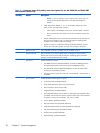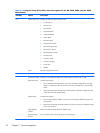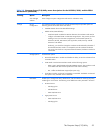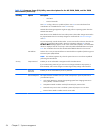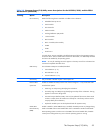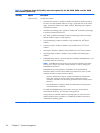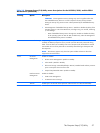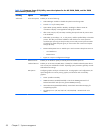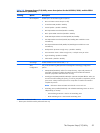
Table 2-2 Computer Setup (F10) Utility menu descriptions for the HP Z420, Z620, and the Z820
Workstations (continued)
Heading Option Description
Advanced
2
Power-On Options Enables you to set the following:
●
POST Messages—Enables or disables the splash screen during POST.
●
Press the ESC key for Startup Menu.
● Option ROM
1
prompt (Enable or Disable)—Enabling this feature causes the
workstation to display a message before loading options ROMs.
●
After Power Loss (On, Off, Last State)—Enabling this option directs the previous state
to be the default.
●
POST Delay (in seconds) (5, 10, 15, 20, None)—Adds a specified delay to the POST
process. This delay is sometimes needed for hard disk drives on some expansion
cards that spin up slowly (so slowly that they are not ready to start by the time POST
is finished). The POST delay also gives you time to select F10 to enter the Computer
Setup (F10) Utility.
●
Remote Wakeup Boot Source—Enables you to set the remote wakeup boot source as:
◦
Local Hard Drive
◦
Remote Server
●
Bypass F1 Prompt on Configuration Changes.
BIOS Power-On Enables you to disable or specify a weekday and time for BIOS power-on.
Onboard Devices Enables you to set resources (IRQ, DMA, I/O Rate) for or disable onboard system devices
such as serial port and diskette controller. Operating system parameters generally override
Onboard Devices settings.
Bus Options Configures graphics cards per workstation slots. In multi-graphics card configurations, this
option designates one card as primary graphics, and the other card as secondary
graphics.
●
Numa—(Enable or Disable)
●
SERR# Generation (Enabled/Disabled)—Controls PCI SERR# generation for ill-
behaved PCI add-in cards (that can generate SERR# spuriously)
●
VGA Palette Snoop (Disabled/Enabled)—Controls PCI VGA Palette Snooping for
compatibility purposes
●
PCI Latency Timer—(32/64/128/160/192/224/248). 128 PCI Clocks is the
default.
58 Chapter 2 System management



